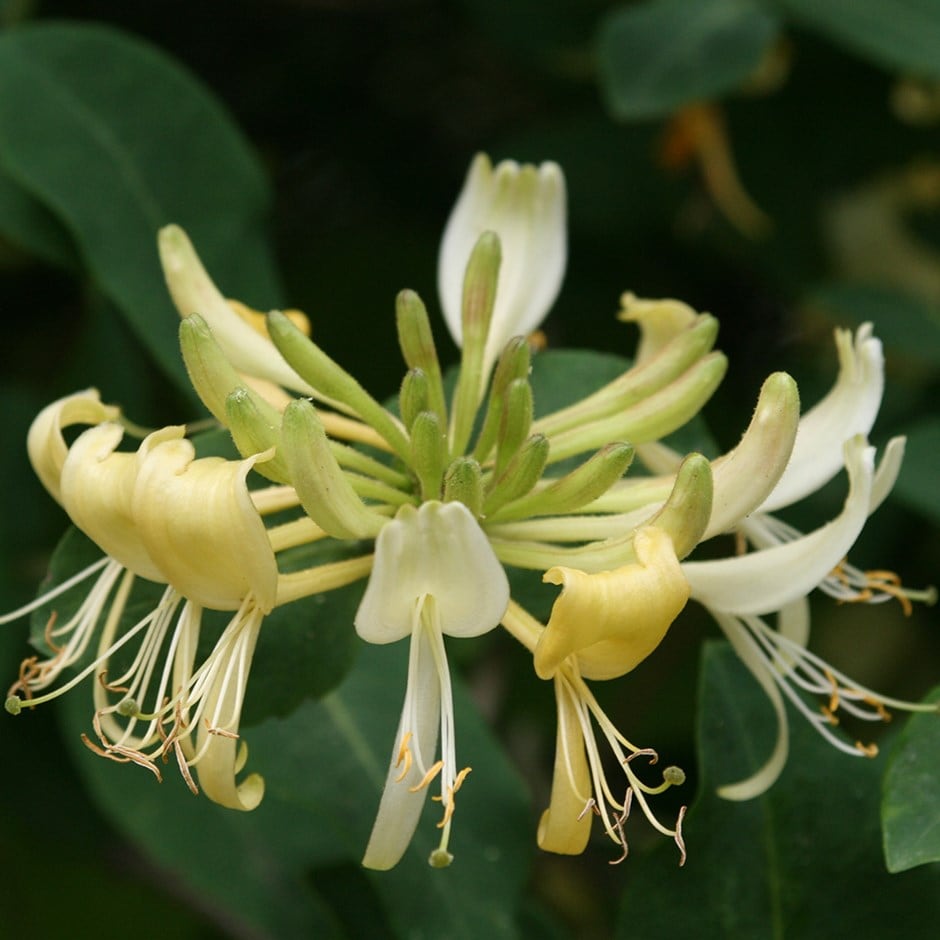
Fabulously fragrant, large, tubular, white flowers, ageing to yellow, from July to September and oval, mid-green leaves. This vigorous, deciduous climber will soon cover a boundary wall or fence in a sunny site. Later flowering than many other varieties of honeysuckle, it's ideal for a cottage or wildlife garden.
How to care for Lonicera periclymenum Graham Thomas:
To avoid dry conditions, and to ensure good soil contact around the rootball, we advise planting climbers at least 30cm (12in), and preferably 45-60cm (18-24in) away from the base of a wall or fence. An even larger distance should be maintained when planting climbers beside an existing tree or shrub.
Cut back established plants after flowering, removing a third of the flowering shoots. Apply a generous 5-7cm (2-3in) mulch of well-rotted compost or manure around the base of the plant in early spring.
Flowering period:
- Jan
- Feb
- Mar
- Apr
- May
- Jun
- Jul
- Aug
- Sep
- Oct
- Nov
- Dec
Eventual height:
Eventual spread:
Position:
Full sun
Rate of growth:
Fast-growing
Soil:
Moderately fertile, moist, well-drained soil
Hardiness:
Fully hardy
-
This climber is deciduous so it will lose all its leaves in autumn, then fresh new foliage appears again each spring.
-
Humans/Pets: Fruit are ornamental - not to be eaten
Product options
Add to basket

Delivery options (pick your preferred option at checkout)
Goes well with
Rosa 'Climbing Iceberg' | Climbing Floribunda Rose
rose Climbing Iceberg (climbing floribunda)

Fabulously fragrant, large, tubular, white flowers, ageing to yellow, from July to September and oval, mid-green leaves. This vigorous, deciduous climber will soon cover a boundary wall or fence in a sunny site. Later flowering than many other varieties of honeysuckle, it's ideal for a cottage or wildlife garden.
How to care for Lonicera periclymenum Graham Thomas:
To avoid dry conditions, and to ensure good soil contact around the rootball, we advise planting climbers at least 30cm (12in), and preferably 45-60cm (18-24in) away from the base of a wall or fence. An even larger distance should be maintained when planting climbers beside an existing tree or shrub.
Cut back established plants after flowering, removing a third of the flowering shoots. Apply a generous 5-7cm (2-3in) mulch of well-rotted compost or manure around the base of the plant in early spring.
Flowering period:
- Jan
- Feb
- Mar
- Apr
- May
- Jun
- Jul
- Aug
- Sep
- Oct
- Nov
- Dec
Eventual height:
Eventual spread:
Position:
Full sun
Rate of growth:
Fast-growing
Soil:
Moderately fertile, moist, well-drained soil
Hardiness:
Fully hardy
-
This climber is deciduous so it will lose all its leaves in autumn, then fresh new foliage appears again each spring.
-
Humans/Pets: Fruit are ornamental - not to be eaten
Product options
Add to basket

Delivery options (pick your preferred option at checkout)
Goes well with
Rosa 'Climbing Iceberg' | Climbing Floribunda Rose
rose Climbing Iceberg (climbing floribunda)
